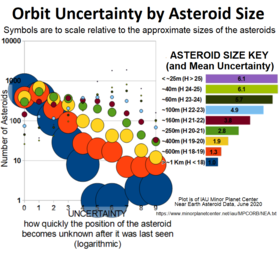Uncertainty parameter
The uncertainty parameter U is a parameter introduced by the Minor Planet Center (MPC) to quantify concisely the uncertainty of a perturbed orbital solution for a minor planet.[2][3] The parameter is a logarithmic scale from 0 to 9 that measures the anticipated longitudinal uncertainty[4] in the minor planet's mean anomaly after 10 years.[2][3][5] The uncertainty parameter is also known as condition code in JPL's Small-Body Database Browser.[3][5][6] The U value should not be used as a predictor for the uncertainty in the future motion of near-Earth objects.[2]
Orbital uncertainty
| JPL SBDB Uncertainty parameter |
Horizons January 2018 Uncertainty in distance from the Sun (millions of kilometers) |
Object |
Reference Ephemeris Location: @sun Table setting: 39 |
| 1 | ±0.04 | 2013 BL76 | JPL |
|---|---|---|---|
| 2 | ±0.14 | 20000 Varuna | JPL |
| 3 | ±0.84 | 19521 Chaos | JPL |
| 4 | ±1.4 | (15807) 1994 GV9 | JPL |
| 5 | ±8.2 | (160256) 2002 PD149 | JPL |
| 6 | ±70. | 1999 DH8 | JPL |
| 7 | ±190. | 1999 CQ153 | JPL |
| 8 | ±590. | 1995 KJ1 | JPL |
| 9 | ±1,600. | 1995 GJ | JPL |
Orbital uncertainty is related to several parameters used in the orbit determination process including the number of observations (measurements), the time spanned by those observations (observation arc), the quality of the observations (e.g. radar vs. optical), and the geometry of the observations. Of these parameters, the time spanned by the observations generally has the greatest effect on the orbital uncertainty.[7]
As an extreme example, 2010 GZ60 has an uncertainty parameter of 9; it could be an Earth threatening asteroid, or may always remain beyond the asteroid belt.
Occasionally, the Minor Planet Center substitutes a letter-code (‘D’, ‘E’, ‘F’) for the uncertainty parameter.
D Objects with a ‘D’ have only been observed for a single opposition, and have been assigned two (or more) different designations ("double"). E Objects such as 1995 SN55 with a condition code ‘E’ in the place of a numeric uncertainty parameter denotes orbits for which the listed Eccentricity was assumed, rather than determined.[8] These are considered lost. F Objects with an ‘F’ fall in both categories ‘D’ and ‘E’.[8]
Calculation
The U parameter is calculated in two steps.[2][9] First the in-orbit longitude runoff in seconds of arc per decade is calculated, (i.e. the discrepancy between the observed and calculated position extrapolated over ten years):
with
uncertainty in the perihelion time in days eccentricity of the determined orbit orbital period in years uncertainty in the orbital period in days , Gaussian gravitational constant, converted to degrees
Then, the obtained in-orbit longitude runoff is converted to the "uncertainty parameter" U, which is an integer between 0 and 9. The calculated number can be less than 0 or more than 9, but in those cases either 0 or 9 is used instead. The formula for cutting off the calculated value of U is
For instance: As of 10 September 2016, Ceres technically has an uncertainty of around −2.6, but is instead displayed as the minimal 0.
The result is the same regardless of the choice of base for the logarithm, so long as the same logarithm is used throughout the formula; e.g. for "log" = log10, loge, ln, or log2 the calculated value of U remains the same if the logarithm is the same in both places in the formula.

| U | Runoff Longitude runoff per decade |
|---|---|
| 0 | < 1.0 arc second |
| 1 | 1.0–4.4 arc seconds |
| 2 | 4.4–19.6 arc seconds |
| 3 | 19.6 arc seconds – 1.4 arc minutes |
| 4 | 1.4–6.4 arc minutes |
| 5 | 6.4–28 arc minutes |
| 6 | 28 arc minutes – 2.1° |
| 7 | 2.1°–9.2° |
| 8 | 9.2°–41° |
| 9 | > 41° |
648 000 is the number of arc seconds in a half circle, so a value greater than 9 would mean that we would have basically no idea where the object will be in 10 years.
References
- "Orbits for Near Earth Asteroids (NEAs)". IAU Minor Planet Center. https://www.minorplanetcenter.net/iau/info/MPOrbitFormat.html: International Astronomical Union. Retrieved 25 June 2020.
- "Uncertainty parameter U". Minor Planet Center. Retrieved 15 November 2011.
- "Mission Design Center Trajectory Browser: Trajectory Browser User Guide". Ames Research Center. Retrieved 3 March 2016.
- "Editorial Notice" (PDF). The Minor Planet Circulars / Minor Planets and Comets (MPC 24597–24780): 24597. 1995-02-15. Retrieved 3 March 2016.
- Drake, Bret G. (1 January 2011). "Strategic implications of human exploration of near-Earth asteroids". NASA Technical Reports Server (NTRS). Retrieved 3 March 2016.
- "Definition / description for SBDB parameter / field: condition code". JPL Solar System Dynamics. Retrieved 15 November 2011.
- "Near-Earth objects close-approach uncertainties". NASA / JPL Near-Earth Object Program Office. 31 August 2005. Retrieved 15 November 2011.
- "Export format for minor-planet orbits". Minor Planet Center. Retrieved 3 March 2016.
- Desmars, Josselin; Bancelin, David; Hestroffer, Daniel; Thuillot, William (Jun 2011). Alecian, G.; Belkacem, K.; Samadi, R.; Valls-Gabaud, D. (eds.). "Statistical analysis on the uncertainty of asteroid ephemerides". SF2A 2011: Annual meeting of the French Society of Astronomy and Astrophysics. Paris, France: 639–642. Retrieved 3 March 2016.

